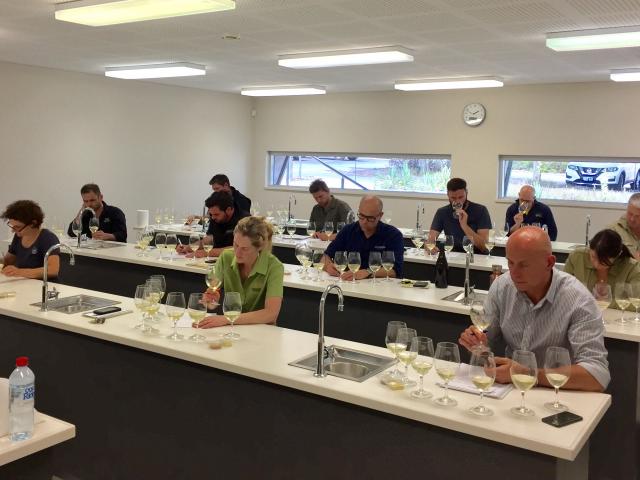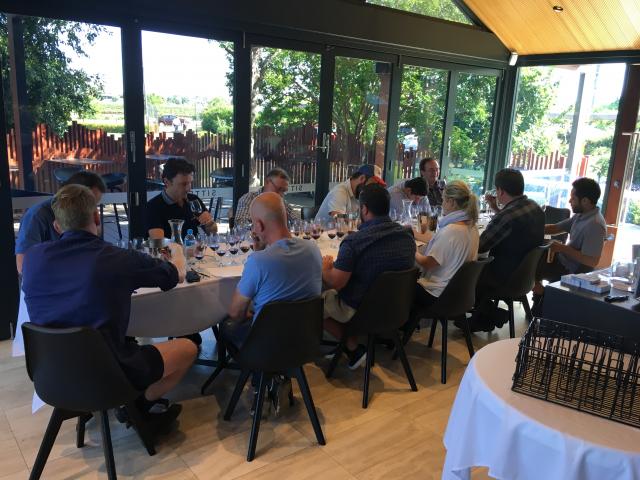Winemakers’ Trial Forum extends to the regions
The Winemakers’ Trial Forum which has been held in Margaret River since 2015 has been extended to also incorporate workshops in the Swan Valley and Great Southern, thanks to funding from the Wine Australia Regional Program.
This funding has also enabled a guest winemaker from outside the state to share experiences, techniques and technologies that may not be familiar to local winemakers at the forums.
Swan Valley
The first of three Winemakers’ Trial Forums was held in the Swan Valley on 3 November 2017.
Twelve local winemakers came together to discuss viticultural and winemaking approaches to three significant varieties for the region; Verdelho, Grenache and Shiraz.
The forum also featured Corrina Wright from Olivers Taranga in McLaren Vale who gave an interesting perspective of growing and making Grenache and Shiraz from McLaren Vale.
Some of the discussion points concerning Verdelho included:
- Fruit ripeness and impact on style.
- Degree of which the fruit is crushing and the impact on quality.
- Use of oak.
- The benefits of co-inoculation of different yeasts.
- Different approaches to fining were discussed and compared.
Some of the discussion points concerning Grenache included:
- Acknowledging the unique resource of old vines in the region.
- General discussion on style from a regional perspective.
- The impact of whole bunches in the ferment and various percentages.
- The importance of managing fermentation temperature.
- Oak handling and format.
Some of the discussion points concerning Shiraz included:
- How wines from a cool ferment (18-20C) compare to a warmer ferment (~25C).
- The effect of whole bunches on the resulting wine.
- The influence of soil type on wine attributes.
Margaret River
Thirteen winemakers shared different viticultural and winemaking trials at the Margaret River workshop held on 28 November 2017.
This is the third consecutive year that this workshop has been held in Margaret River, promoting innovation and collaboration within the region.
This year’s event featured guest wine maker Andrew Hales from Penfolds.
Andrew shared insight into Chardonnay and Cabernet production from a non-WA perspective, including detailing the clones sourced by Penfolds from premium wine regions in South Austraila and Victoria.
An interesting discussion covered the diversity of Cabernet clones in Coonawarra and how wine traits have been observed to differ between them.
Andrew also provided insight into how Penfolds manage their wines in barrels especially relating to storing them at 2 o’clock and minimal rackings during maturation.
Local winemakers presented four trials focussing on key varietals Chardonnay and Cabernet Sauvignon, including viticultural or winemaking treatments that aim to improve wine quality and production efficiencies.
The group tasted the wines ‘blind’, followed by a group discussion on differences and preferences of the various treatments.
Trials included:
- Chardonnay oak exchange
- Margaret River chardonnay clones
- Great Southern chardonnay clones
- Cabernet Sauvignon planting density and fermenter configuration
- Cabernet Sauvignon tannin trials
Chardonnay oak exchange
This innovative trial examined the impact of fermenting and maturing a parcel of Chardonnay and exchanging the wine into and out of new/old oak barrels over three separate time periods.
The aim was to demonstrate the impact and interaction that can be achieved by utilising old barrels with new barrels during the fermentation and maturation process.
The treatments were:
| Fermentation vessel | Maturation vessel | Timing of wine exchange |
|---|---|---|
| New barrel | New barrel | n/a (control) |
| Old barrel | Old barrel | n/a (control) |
| New barrel | Old barrel | Immediately after fermentation |
| Old barrel | New barrel | Immediately after fermentation |
| New barrel | Old barrel | 1 month after fermentation |
| Old barrel | New barrel | 1 month after fermentation |
| New barrel | Old barrel | 3 months after fermentation |
| Old barrel | New barrel | 3 months after fermentation |
The group didn’t have a clear preference between the control wines or those exchanged immediately after fermentation. They did however show a clear preference to the wines that had been fermented in new barrels and exchanged to older barrels after one or three months.
Overall the group agreed that this trial showed the significance of fermenting and storing Chardonnay in new barrels, but that integrating old barrels into the maturation process may contribute interesting blending options.
Margaret River Chardonnay clones
Five clones of Chardonnay grown in Margaret River were presented blind to the group. These wines were produced from the national research project ‘Assessing clonal variability in Chardonnay and Shiraz for future climate change’.
Clones 277 and Gingin were well received by the group, while 96 and 95 were the lesser preferred clones.
Great Southern Chardonnay clones
The wines produced from the same national trial were grown at a vineyard in Mt Barker.
The group found this bracket of wines difficult to distinguish by quality traits but there was a distinct variation in style.
Styles ranged from citrus/lime to a more stonefruit/orchard fruits flavour spectrum.
I10V1 was the least preferred clone which, in discussion, was attributed to the wine being lower in acidity than the other three clones and picked at a slightly higher Baume.
Cabernet Sauvignon planting density and fermenter configuration
A parcel of Cabernet (clone 126) was split and fermented in a small (2t) format custom built conical fermenter and a large (10t) conventional fermenter. These were tasted and compared.
Another parcel of Cabernet (Houghton clone) planted at high density (1m x 1.5m) was also split between these two fermenter configurations and presented to the group.
For both parcels the group preferred the wines fermented in the small fermenters (71% and 64% respectively) and the wines from the high density planting were greater in colour and concentration compared to the other parcel.
Cabernet Sauvignon ferment tannin trials
Different fermentation tannins were added to a parcel of Cabernet that was split into three tanks. The tannins Scott Tan FT Rouge, Incanto NC Rouge and VR Supra were added at ferment at similar rates to investigate the performance of the tannins.
There were clear differences between the treatments and overwhelmingly 79% of the group preferred the wine that had received the Incanto NC Rouge tannin addition. It was also noted that this tannin was the most expensive of the three.
The Department of Primary Industries and Regional Development intends to hold this forum on a regular basis to provide WA winemakers with the opportunity to share experiences and promote innovative approaches to improving production efficiencies and wine quality.
For more information contact Richard Fennessy, Research Officer on +61 (0)8 97 80 6219.


